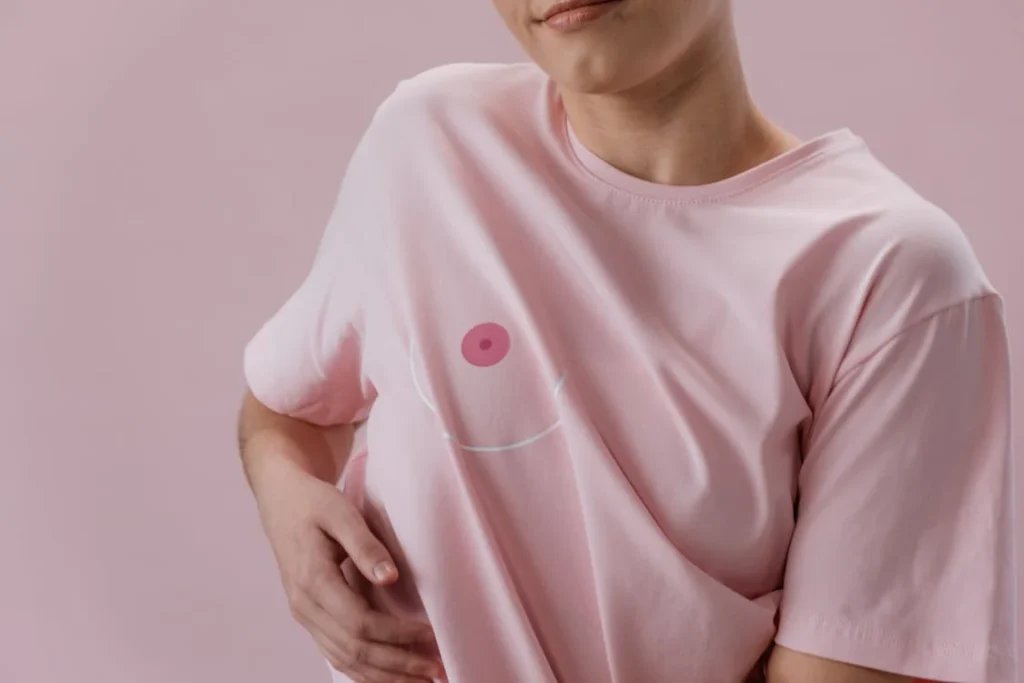A Meditation on the Politics of Bodily Autonomy
By Debarati Mukherjee

There is something about a woman’s chest that refuses to disappear.
Society would like to fold them neatly under cotton and wiring— there but never really seen. Muted. And yet, this temple of flesh persists, often sacredly declaring itself from underneath the silk and linen.
I watched a viral moment streaming from Paris, on International Women’s Day this year. Hundreds of women were parading the streets, topless. Most had their torsos painted like canvases of dissent— in bold colours, blooming and alive: to demonstrate against the rising fascism towards women around the world. They were saying, Free the Self.
When I saw those women boldly taking to the streets, I felt something shift in me (while most of the world I assumed went on as it does— amused and scandalised) I noticed my body trembling with something closer to awe. It was me reacting to my mind’s signals— tangled up with memories of being systemically policed. I gaped at their unabashed protest. A reclaiming of something small yet incendiary: their breasts. This movement while being reprised on International Women’s Day is also part of a global wave called #FreeTheNipple, which emerged over a decade ago in the United States. Catapulted into public conversation by Lina Esco’s 2014 documentary of the same name. The film challenged the double standards in censorship laws—where male nipples are considered ordinary, while female nipples are scandalous, sexual, and even dangerous. Yet these Parisian women were no celebrities and had no security guards looking out for them. They were regular civilians, like me.
The Paris movement had gone viral of course and the matter had, as you may imagine, raised many an eyebrow. Yet in my own country, and across most parts of the globe, such acts of self-expression are met with a disapproving silence, or harassment on social media, or a lot worse. For a movement that provokes such discomfort, shall I then refer to it as the liberation of the Mamilla? But even a cold scientific jargon, a purely biological term, such as this, still bristles against the social ear. But why? Is this not biology? Is it not the mark of mammalian tenderness that allows a baby to survive, to be fed and held and comforted?
I speak not from the dais of a scholar but from the hearth of lived experience. In my tier-one city apartment in India, nestled comfortably in the suburbs, I have often encountered the gaze— that peculiar scanning look that lands squarely upon a woman’s chest. After long hours of work, and upon returning to the sanctity of my home I have met with pointed stares at my T-shirt by older women—with the weight of tradition pressing on their eyes, for choosing to forego wearing my brassiere : Men shouldn’t be made to feel uncomfortable. And just like that, my comfort was repositioned as an insinuation or admonishment. The privilege of the patriarch is the unspoken law of the household.
Such incidents are one in many. Because this isn’t just about one family. It’s a pattern stitched into the social fabric. Hence, despite the movement in Paris spreading through social media like wildfire, its flames didn’t reach the shores of many a land. This speaks to the movement’s—and society’s—inherent blind spots.. #FreeTheNipple movement has often centered white, cis, able-bodied. For trans women, Black and Asian women, and those shaped by religious codes, such protests are not just policed—they risk criminalisation, fetishisation, or erasure. What is praised as ‘defiance’ for some is ‘catastrophic’ for others. And so, In South Asia, where honour and violence often walk together, this becomes a meditation on a vast and layered struggle. In India alone, such acts can invite not dialogue but arrest, doxxing, assault, or worse. Respectability remains both shield and shackle. Honour is a currency we’re told we carry between our legs and across our chests. To expose oneself is to bankrupt that account entirely.
Not all bodies are free to be political in the same way. The bare chest that provokes applause in Paris might provoke violence in Patna, Nairobi, or Jackson — just as, in parts of colonial India, Dalit women were forbidden from covering their chests, punished not for defiance but for dignity. Resistance is unequal — since power has never been evenly distributed.
This meditation returns, finally, to its genesis: the breast as metaphor. A powerful one, yes—but still a fragment of something larger: the woman’s body in all its complexity. And at its heart the question is not about modesty, but ownership. Who owns the female body? The state, with its dress codes and censored nipples? The family, which policies domestic attire? The marketplace, which packages freedom in lace and illusion?? Or the woman herself? In our schools, they are monitored. In our courts, they are judged for morality. And on the internet, they are algorithmically erased. Instagram will take down an image of a breastfeeding mother before it takes down a hate-filled rant. This is not about nudity. It never was. I’ve felt roving eyes everywhere—on trains, in queues, in offices, at college—regardless of what women wore. The female breast is treated like a national threat: surveilled, legislated and blurred on repeat. Many memories live in my torso. They curl under my ribs, and throb under my throat ready to spill out in protest. I have lived so many lives in silence around this subject. So, when I saw these women so boldly protesting for women’s rights, I did not see a spectacle. I saw subversion. Women baring their torsos in public like open texts. It reminded me of women from another time—sixteenth-century Europe, perhaps—when they were branded as ‘witches’ for thinking, speaking, and disobeying. Hence as history attests, the female body, especially when uncontained, has been interpreted as a threat. The answer is still unknown, as to what we must do. Can we all take to the streets, baring ourselves to the world, to demand for social justice? Perhaps it is not feasible to do so in all parts of the world. Yet Feminism has many faces, and the one on the streets of Paris—painted, bare, unapologetic—is no less noble for its daring. It does not even ask for universal participation, but it does demand recognition and understanding. Bodily autonomy is not about exposure. It’s about freedom without fear. It’s about the right to say this is mine—this skin, this pain, this pleasure, this breast, this breath.
Although that world is not yet here, it is not impossible. And until it arrives, I will carry this quiet rebellion inside me. In the end, it is not really about breasts. It is about centuries of control, and lifetimes of stolen agency. It is about a truth: that the female body is neither a battleground, nor a burden. It is a body. In that body, there is power. And in that power, peace. I will remember the women on the streets of Paris representing bodies like my own. And I will hope that one day, the liberation of something as small as a breast might shift something vast for humanity
Debi’s work explores themes on identity, resilience and intricacies of relationships. With a science major in Microbiology and a subsequent Business degree, she had been a corporate leader of eighteen years, and has now fully embraced her literary passion. She currently resides in Bangalore and pursues writing short stories and reading and writing poetries. She is also working on a novel set in the late colonial period based in the North East of India. Her poems have been published in the annual poetry anthology of Wingword Poetry competition, and in distinguished regional cultural magazines.

Join our newsletter to receive updates